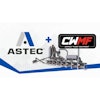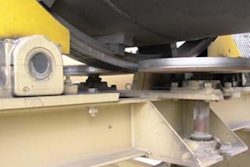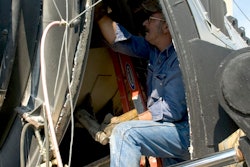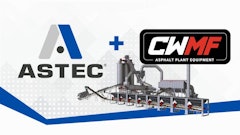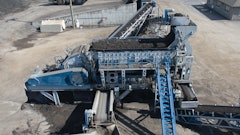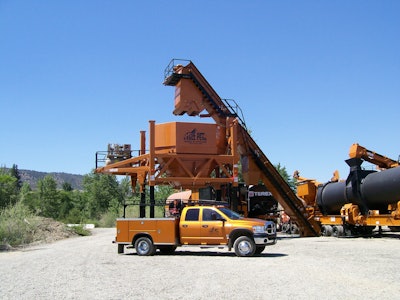
So you’ve decided to buy your own Asphalt Plant. Great choice! Now you are going to be called on to make a lot more important decisions like AC plant type, style, size, brand and budget. Once you've made those choices, more issues crop up, such as AC tank size, storage silo size, number of cold feed bins, type of pollution controls and on and on and on... For someone new to asphalt plants these are baffling issues.
In what follows I am going to try to demystify the process through which all these choices are made. I will attempt to explain the various types and styles of AC plants and to help you with those choices.
There are two TYPES of Asphalt Plants. Drum Mix and Batch.
BATCH PLANTS
A batch plant makes mix in batches. Aggregate is fed by the feeders to a rotary dryer where the moisture is removed. It is then transported to a set of screens where it is divided into several component sizes (3/4-in.-1/2-in., 1/2-in.-1/4-in., 1/4-in.-1/8-in. and 1/8-in.-0-in. for example) and stored in 'hot-bins'. These aggregates are then correctly proportioned into a weigh bin by the plant's blending computer. From here it is introduced into a pugmill and 'dry-mixed' for a specified amount of time. The oil is introduced at the proper time and the combination is then 'wet-mixed' for the required time. At the end of this cycle the pug gate opens and the finished hot-mix is either discharged directly into a waiting truck or it is dropped into a moveable chute which leads to a slat conveyor and then a holding silo.
Batch plants range in size from a 250-lb. baby Madsen (the smallest I know of) up through 18,000-lb. monsters. They are generally rated at one batch per minute, so a 4,000-lb. plant would yield 120 tons per hour, while an 18,000-lb. unit would yield 540 tons per hour.
Strengths:
A batch plant's strength lies in its ability to make salable hot mix out of almost any reasonable stockpile of aggregate. As one old timer put it: "You can feed 'er meteors and coprolites and I'll make spec mix, sonny!" He was one wise old man.
Another strength inherent to a batch plant is its ability to switch mix specifications mid-truck if needed. Essentially, if you supply the plant with 3/4-in.-0-in. aggregate you can make any mix that uses materials contained within those parameters. Depending on what screens you have installed in the plant, you can make 3/8-in.-0-in. mix for one truck, then switch to 3/4-in.-0-in. mix for the next and still be able to blend a nice 1/2-in.-0-in. mix for the third. In some operating situations this is a very valuable ability.
Weaknesses:
A batch plant utilizes numerous steps to produce hot-mix. It is those very steps that make it so valuable to someone in the position described under strengths. And those same steps are its weakness to an operator who is making the same mix all the long day. What it boils down to is the fact that a batch plant spends about 30% of its time waiting on bins to weigh up, the pug-mill to empty and similar activities. To an operator who does not have to make a lot of daily mix changes and is concerned with high production, perhaps a batch plant is not the right choice.
DRUM PLANTS
What is a drum mix asphalt plant? Essentially, a drum mix plant is a continuous mix facility that takes the hot-mix manufacturing process to its basics. In the feeders it proportions the aggregates into the correct blend to meet job requirements. This material is then conveyed to the dryer/mixer where the first two thirds of the unit is dedicated to moisture removal. In the last third of the unit the correct percentage of asphalt is injected and the resultant material is thoroughly mixed. At this point it is discharged into a slat conveyor for transport to a storage silo where it is distributed to the waiting trucks.
Drum plants range from 8 ton per hour toys to 800 ton per hour giants. The most common plants are between 150 & 400 tons per hour.
Drum Mix plants also come in two configurations: Parallel Flow and Counter Flow. In the beginning, almost all Drum mix plants were of the Parallel Flow variety, meaning that the aggregate and the Burner Flame traveled down the drum in the same direction. In recent years the Counter Flow technology has become dominant. In this configuration the aggregate travels down the drum toward the burner. Minimizing source emissions is the driving force behind this style of plant.
Strengths:
The fact that a drum plant reduces the hot mix process to its essentials is its big strength. By eliminating most of the steps taken by a batch plant to produce mix a drum plant is able to do its job more economically. They will also operate at a higher rate of production for a given drum size, since the mixing process is continuous.
Weaknesses:
By the nature of their design, drum plants are limited to producing one mix design at a time. If you introduce properly gradated 1/2-in.-0-in. aggregate into the unit you are going to get the same thing out of it. For a contractor who is required to supply several different mix-designs in the same production run a drum plant may not be the best choice. This problem can be overcome through the use of multiple silos and a sharp operator, but multiple silos are not as practical if you must be portable.
Plant Selection Summary
Basically, a batch plant is the best choice for an operation where the plant will be called upon to make various blend mixes in the same operational 'run', or if the plant will be doing a lot of starting and stopping in the course of the day. A drum plant is the correct plant for a company not concerned with switching back and forth to various mixes and foresees the luxury of long production runs. Another consideration is the fact that batch plants utilize many more moving parts than drum plants, therefore they are more expensive per ton to operate and year end maintenance costs are higher.
STYLES OF ASPHALT PLANTS
There are two styles of asphalt plants, portable and stationary. It's fairly easy to choose between the two, once you know the answers to a couple of questions: Do you need to move your plant? If so, how often will it be moved?
One incontrovertible rule is that portable plants cost substantially more than their stationary brethren. If you only need to move your plant once every few years then it is possible that the cost of moving the plant is considerably less than the cost of portability on the original order. I recommend that companies in this category consider buying a skid-mounted plant with flexible wiring, like SO cord, equipped with quick disconnects.
Companies that plan to move their plants several times a year must purchase a portable facility. When looking at these units it is strongly recommended that a self-erect silo/drag combination be considered. In the Northwest a crane to set the silo and drag conveyor can easily cost in excess of $5,000 per move. It doesn't take a rocket scientist to see that if you move your plant four times a year, you can pay for the difference in cost for a self-erect in about two years.
SIZE OF ASPHALT PLANT?
How much production do you need? This is a difficult question to answer. One of the fundamental mistakes that I see is a company trying to size their plant to their highest production days. I recommend that a plant be sized to the average for a company's busiest month.
New companies, without a track record for mix production, must analyze their market and decide from there. If you feel that you can sell 3,000 tons per day, 10% of the time and 1,000 tons per day the rest of the production season, I suggest that a 200 ton per hour plant is more appropriate than a more expensive 400tph unit. Thinking along the same lines, it's difficult to justify the multi-million dollar cost of a new 350tph plant if you plan on making 40,000 tons a year, regardless of how fast you can make it.
To summarize, plant sizing is a function of market demand. Try not to size the plant so small that in a year or so you will be looking to upgrade to a bigger facility. But then again, don't go so big that the thing is idle for long periods of time. In general, a plant is most efficient when it is running at about 80% of its rated capacity, and the things last longer when they are not stopped and restarted constantly. Another thought: A smaller AC plant with lots of storage capacity can often turn out as much mix on a given paving day, because it might not have to stop while waiting for trucks, while the larger plant fills its silo in a hurry and then must wait for the silo level to go down. This dead time takes away from productivity and adds to the cost per ton of mix..
CONFIGURATION
There are numerous other factors past price and size that you will need to consider when choosing a plant. Some of these things are:
AC Tank Size: How far away from your proposed plant site is the nearest oil supplier? How long does it take to lap a truck from your plant to the refinery and back? These are questions that need to be answered before you can decide on oil storage capacity. In general, a 300tph plant will use about 17.4 tons of oil per hour at a mix design percentage of 5.8%. A 30,000 gallon tank holds roughly 116.7 tons of oil at 7.78ppg (approximate weight of PGA-58-22 @ 300degrees). Since we cannot pull all of the oil out of the tank because they are set-up so that the heaters stay immersed in oil (electric models) let's assume we can use 114 tons of liquid. At 17.4 tons per hour we can run approximately 6.5 hours on the oil we have. To stay even with our rate of consumption we will need to get a 35ton load of oil every 2 hours. If this is not possible, we need to increase our oil storage capacity. In general I advise buying as much storage as you can afford. This means you are not as much at the mercy of your oil supplier and his trucks.
Hot Mix Storage: Larger silos generally mean less truck turn-around time in the yard, which equates to more money on the bottom line. A large capacity silo can also help a smaller plant perform with the big boys as far as mix shipped per hour, since when the trucks are gone the plant can run longer, refilling the silo. If you start the plant early enough in the morning to have the silo full when the first truck loads, it will help the plant stay ahead of the trucking for several hours. In general, buy as much storage as you can afford. I tell contractors that it's easy to put 50 tons in a 200 ton silo, it's tough to put 60 tons in a 50 ton silo.
Cold Feeds: Does your state use mixes that require the aggregates to be broken down into more than one or two stockpiles, such as 3/4"-1/2", 1/2"-1/4", 1/4"-10 and 10-0"? If so you will need to make sure your new plant accommodates all the materials you will need to be using. If you have to blend sand into your mixes you could find that you need 5 feed bins.
Buying an asphalt plant is a big step, and the best advice I can think of is to be thorough. Research your market and know your potential customers. Ask yourself the tough questions: What will it take to get the business away from those who will be your competitors? What do you have to offer them that the other guy doesn't?
If you plan to buy a plant to service your own paving operation then ask yourself how a plant will aid in that operation. Will it give you access to mixes you can't get elsewhere? Will it reduce you paving crew’s ‘Down-Time’ waiting on trucks? Do you have enough yearly volume to support the payments on such a large investment? Once you have a thorough understanding of these issues you are ready to proceed with the purchase of a plant if it is warranted. Be just as thorough in your investigations of potential pieces of equipment. Ask questions and seek advice from anyone knowledgeable in the subject. Money spent on plant appraisals and consulting help could turn out to be the best investment you make. One last bit of advice: Start on the Air Quality Permit process the minute you decide to get a plant. This process, under adverse conditions, can drag on for months and under some situations actually kill the entire project. Know your prospects for getting all the needed permits first!
